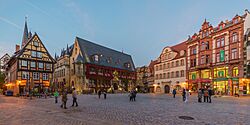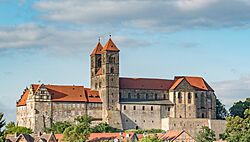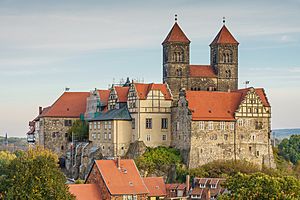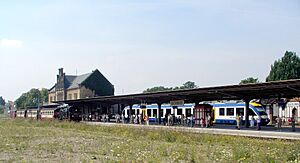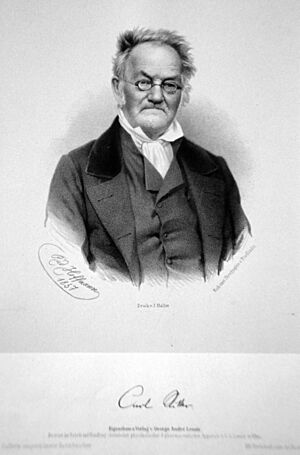Quedlinburg facts for kids
Quick facts for kids
Quedlinburg
|
||
|---|---|---|
|
Top: View over Quedlinburg. Middle: Market Square. Bottom: Quedlinburg Castle and Abbey
|
||
|
||
| Country | Germany | |
| State | Saxony-Anhalt | |
| District | Harz | |
| Elevation | 123 m (404 ft) | |
| Population
(2022-12-31)
|
||
| • Total | 23,313 | |
| Time zone | CET/CEST (UTC+1/+2) | |
| Postal codes |
06484, 06485
|
|
| Dialling codes | 03946, 039485 | |
| Vehicle registration | HZ, HBS, QLB, WR | |
| Website | www.quedlinburg.de | |
| UNESCO World Heritage Site | ||
| Official name | Collegiate Church, Castle, and Old Town of Quedlinburg | |
| Criteria | Cultural: iv | |
| Inscription | 1994 (18th Session) | |
| Area | 90 ha | |
| Buffer zone | 270 ha | |
Quedlinburg is a historic town in Germany, located just north of the Harz mountains. It's in the Harz district of Saxony-Anhalt. This town was very important for trade in the early Middle Ages. It became a powerful center under the Ottonian dynasty in the 10th and 11th centuries.
The town's castle, church, and old town are incredibly well-preserved. They feature about 2,100 timber-framed houses from that influential time. Because of its amazing preservation and beautiful Romanesque architecture, Quedlinburg was added to the UNESCO World Heritage List in 1994.
Today, Quedlinburg has over 24,000 people living there. It used to be the capital of its own district until 2007. Many places in Quedlinburg are special stops on the Romanesque Road, a scenic holiday route.
Contents
A Look Back: Quedlinburg's History
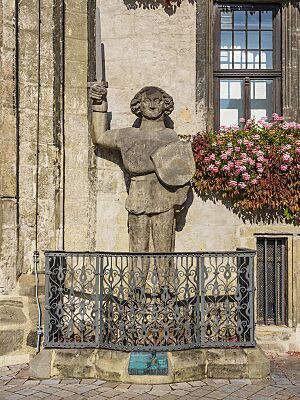
Quedlinburg has been around since at least the early 9th century. It was first officially mentioned as a town in 922. This happened when King Henry the Fowler made a special gift, recorded by the abbey of Corvey.
Legend says that Henry was offered the German crown in Quedlinburg in 919. This led to the town being called the "cradle of the German Reich," meaning the birthplace of the German Empire.
Founding of the Abbey and Imperial Importance
After King Henry died in 936, his wife, Saint Matilda, started a special community for women on the castle hill. Here, daughters of important families were educated. This community, called Quedlinburg Abbey, had a main job: to pray for King Henry and future rulers. They also wrote important historical records called the Annals of Quedlinburg. The first leader of the abbey was Matilda, King Henry's granddaughter.
The Quedlinburg castle was an important royal palace for the Saxon emperors. It was founded by King Henry I and built up by Emperor Otto I in 936. The men's part of the community was in the valley, where the Church of St. Wiperti is now. The women's community was on the castle hill.
In 973, Emperor Otto I held a big meeting called a Reichstag in Quedlinburg. Many important nobles from far-off places like Poland and Bohemia came to show their respect. Otto I also introduced his new daughter-in-law, Theophanu, a Byzantine princess. Her marriage to Otto II was hoped to bring peace between the Eastern and Western empires.
In 994, Emperor Otto III gave Quedlinburg the right to have a market, collect taxes, and make coins. This led to the creation of the town's first marketplace.
Changes Over the Centuries
Quedlinburg joined the Hanseatic League in 1426. This was a powerful group of trading towns. However, the Quedlinburg Abbey often disagreed with the town's independence. In 1477, the Abbess Hedwig, with help from her brothers, stopped the town's resistance. Quedlinburg had to leave the Hanseatic League and was then protected by the Electorate of Saxony. Both the town and the abbey became Protestant in 1539 during the Protestant Reformation.
Later, in 1697, the rights to Quedlinburg were sold to Frederick III of Brandenburg. The abbey continued to challenge this for many years. In 1802, the abbey was closed, and Quedlinburg became part of Prussia. During the Napoleonic Wars, it was part of the Kingdom of Westphalia for a short time (1807-1813). Then, in 1815, it became part of the new Prussian Province of Saxony. During these times, the leaders of Quedlinburg Abbey were ladies who did not have to become nuns. They were even free to marry. The last of these leaders was Sofia Albertina, a Swedish princess who supported women's rights.
Quedlinburg in Modern Times
During the time of the Nazi regime, the memory of King Henry I became very important to some leaders. The collegiate church and castle were seen as very special places. The church was closed in 1938 and during World War II. Quedlinburg was affected by the war, and some medieval art was stolen by an American soldier. This art was later returned to Quedlinburg in 1993.
After World War II, Quedlinburg was part of East Germany from 1949 to 1990. When Germany reunited in 1990, it became part of the state of Saxony-Anhalt. During the Communist era, experts from Poland helped repair the old buildings. Today, Quedlinburg is known for its work in restoring its beautiful Fachwerk (half-timbered) houses.
Quedlinburg was also the setting for the movie Frantz in 2016. The film shows the town as a typical small German town after World War I.
Exploring Quedlinburg's Geography
Location and Landscape
Quedlinburg is located north of the Harz mountains, about 123 meters (403 feet) above sea level. The highest nearby mountains reach 181 meters (594 feet). Most of the town is in the western part of the Bode river valley. The Bode River flows from the Harz mountains into the Saale River, which then joins the Elbe River. The total area of Quedlinburg is about 120.42 square kilometers (46.5 square miles).
Town Divisions
The town of Quedlinburg includes Quedlinburg itself and several smaller areas called Ortsteile or municipal divisions:
- Bad Suderode
- Gernrode
- Gersdorfer Burg
- Morgenrot
- Münchenhof
- Quarmbeck
Nearby Towns
Quedlinburg is surrounded by other communities:
 |
Halberstadt | Oschersleben | Magdeburg |  |
| Blankenburg | Aschersleben | |||
| Nordhausen | Sangerhausen | Halle |
Weather in Quedlinburg
Quedlinburg has an oceanic climate, meaning it gets winds from the Atlantic Ocean. Snow usually falls almost every winter. January and February are the coldest months, with average temperatures around 0.5 °C (33 °F) and 1.5 °C (35 °F). July and August are the warmest, averaging 17 °C (63 °F) and 18 °C (64 °F).
The town gets about 438 mm (17 inches) of rain each year. Most of the rain falls from May to September. This is one of the lowest amounts of rainfall in Germany.
| Climate data for Quedlinburg | |||||||||||||
|---|---|---|---|---|---|---|---|---|---|---|---|---|---|
| Month | Jan | Feb | Mar | Apr | May | Jun | Jul | Aug | Sep | Oct | Nov | Dec | Year |
| Mean daily maximum °C (°F) | 2 (36) |
4 (39) |
8 (46) |
13 (55) |
19 (66) |
21 (70) |
22 (72) |
23 (73) |
19 (66) |
13 (55) |
6 (43) |
3 (37) |
13 (55) |
| Daily mean °C (°F) | 0.5 (32.9) |
1.5 (34.7) |
4.5 (40.1) |
8.0 (46.4) |
13.5 (56.3) |
15.5 (59.9) |
17.0 (62.6) |
18.0 (64.4) |
14.0 (57.2) |
9.5 (49.1) |
3.5 (38.3) |
1.5 (34.7) |
8.9 (48.1) |
| Mean daily minimum °C (°F) | −1 (30) |
−1 (30) |
1 (34) |
3 (37) |
8 (46) |
10 (50) |
12 (54) |
13 (55) |
9 (48) |
6 (43) |
1 (34) |
0 (32) |
5 (41) |
| Average precipitation mm (inches) | 23 (0.9) |
22 (0.9) |
28 (1.1) |
38 (1.5) |
53 (2.1) |
57 (2.2) |
47 (1.9) |
54 (2.1) |
33 (1.3) |
27 (1.1) |
30 (1.2) |
26 (1.0) |
438 (17.3) |
| Average rainy days | 11 | 9 | 10 | 10 | 10 | 11 | 10 | 10 | 9 | 9 | 11 | 12 | 122 |
| Average relative humidity (%) | 87 | 83 | 82 | 74 | 67 | 71 | 72 | 69 | 78 | 82 | 87 | 86 | 78 |
| Mean monthly sunshine hours | 47.2 | 66.9 | 107.5 | 136.7 | 182.6 | 172.2 | 186.4 | 183.6 | 139.0 | 104.9 | 63.2 | 42.1 | 1,432.3 |
| Source 1: Deutscher Wetterdienst, Normalperiode 1961–1990 | |||||||||||||
| Source 2: Zoover | |||||||||||||
Population Over Time
| Historical population | ||
|---|---|---|
| Year | Pop. | ±% |
| 1786 | 8,382 | — |
| 1807 | 10,476 | +25.0% |
| 1820 | 11,507 | +9.8% |
| 1830 | 12,001 | +4.3% |
| 1840 | 13,431 | +11.9% |
| 1852 | 13,886 | +3.4% |
| 1861 | 14,835 | +6.8% |
| 1871 | 16,800 | +13.2% |
| 1880 | 18,437 | +9.7% |
| 1890 | 20,761 | +12.6% |
| 1900 | 23,378 | +12.6% |
| 1910 | 27,233 | +16.5% |
| 1919 | 28,190 | +3.5% |
| 1939 | 30,320 | +7.6% |
| 1946 | 35,142 | +15.9% |
| 1950 | 35,555 | +1.2% |
| 1955 | 33,125 | −6.8% |
| 1960 | 30,965 | −6.5% |
| 1965 | 30,840 | −0.4% |
| 1970 | 30,829 | −0.0% |
| 1975 | 29,711 | −3.6% |
| 1980 | 28,585 | −3.8% |
| 1985 | 29,394 | +2.8% |
| 1990 | 28,663 | −2.5% |
| 1995 | 25,844 | −9.8% |
| 2000 | 24,114 | −6.7% |
| 2005 | 22,607 | −6.2% |
| 2009* | 21,203 | −6.2% |
| Source: | ||
How Quedlinburg is Governed
The current mayor of Quedlinburg is Frank Ruch. He was elected in 2022 and is a member of the CDU party.
Sister Cities Around the World
Quedlinburg has special partnerships with other towns, called twin towns:
 Aulnoye-Aymeries, France, since 1961
Aulnoye-Aymeries, France, since 1961 Herford, Germany, since 1991
Herford, Germany, since 1991 Celle, Germany, since 1991
Celle, Germany, since 1991 Hameln, Germany, since 1991
Hameln, Germany, since 1991 Hann. Münden, Germany, since 1991
Hann. Münden, Germany, since 1991
Things to See and Do in Quedlinburg
Quedlinburg's town center is full of amazing half-timbered buildings. Some of these houses are from the 14th century, making them among the oldest in Germany! On the edges of the old town, you can also see beautiful Jugendstil buildings from the late 1800s and early 1900s.
The old town of Quedlinburg is one of the largest in Germany, covering about 90 hectares. It has around 2,000 half-timbered houses. The oldest one, called the "Ständerbau," dates back to 1347.
You can also visit the "Klopstockhaus," which is the birthplace of the famous poet Friedrich Gottlieb Klopstock.
Since December 1994, Quedlinburg's old town and the castle hill with the Stiftskirche (collegiate church) have been UNESCO World Heritage Sites. Quedlinburg is special because it's one of the best-preserved medieval and Renaissance towns in Europe. It didn't suffer much damage during World War II.
In 2006, a special steam narrow-gauge railway was extended to Quedlinburg from Gernrode. This railway, part of the Harz Narrow Gauge Railways, lets you explore the scenic Selke valley and the high Harz plateau.
The castle and the Stiftskirche St. Servatius still stand tall over the town, just like they did in the Middle Ages. The church is a great example of German Romanesque architecture. The church's valuable collection of ancient Christian items and books was once stolen but was returned in 1993. You can see it on display again today.
The former Stiftskirche St. Wiperti was built in 936. It stands where the first royal palace of the Ottonian emperors was located in Quedlinburg. Around 1020, a special underground room called a crypt was added to the church. This crypt has survived through the years and is now a stop on the Romanesque Road.
Getting Around Quedlinburg
Transportation Options
Air Travel
The closest major airports to Quedlinburg are Hannover, about 120 kilometers (75 miles) northwest, and Leipzig/Halle Airport, about 90 kilometers (56 miles) southeast. There's also a smaller airport, Magdeburg-Cochstedt, which has fewer flights. For smaller private planes, an airfield is located at Ballenstedt-Assmussstedt.
Train Services
Regional trains run by Deutsche Bahn and the private Transdev company connect Quedlinburg station to cities like Magdeburg, Thale, and Halberstadt.
Since 2006, the Selke Valley branch of the Harz Narrow Gauge Railways has reached Quedlinburg. This historic steam-powered narrow-gauge railway offers a unique way to travel to Alexisbad and the beautiful High Harz plateau.
Bus Services
Quedlinburg has regional buses that connect it to nearby villages and small towns. You can also find long-distance buses that travel to Berlin.
Quedlinburg in Media and Arts
The Mitteldeutsche Zeitung (Central German Newspaper) has a local news office in Quedlinburg. Other local newspapers include SuperSonntag, Wochenspiegel, and Harzer Kreisblatt.
The local public radio and TV station is Mitteldeutscher Rundfunk (MDR). Regionalfernsehen Harz (RFH) broadcasts on the local cable television network.
Many books have been set in Quedlinburg and the surrounding area. These include works by Wilhelm Raabe, Theodor Fontane, and Julius Wolff. Other authors like Gerhard Beutel, Helga Glaesener, and Christian Amling have also used Quedlinburg as a setting for their stories.
Because of its historic buildings, Quedlinburg has been a popular location for movies and TV shows. Several episodes of the series Ärger im Revier were filmed here. From 2012 to 2017, the ARD series Heiter bis tödlich: Alles Klara was filmed in and around the city.
Many films have also been partly filmed in Quedlinburg, including:
- 1938: Spiel im Sommerwind
- 1954: Paul the Puppeteer
- 1960: Fünf Patronenhülsen (Five Cartridge Cases)
- 1964: Mir nach, Canaillen! (Follow Me, Plebs!)
- 1971: Polizeiruf 110, four episodes
- 1972: Nicht schummeln, Liebling! (Don't Cheat, Darling!)
- 1972: Lützower
- 1974: Casimir the Great
- 1974: Hans Röckle und der Teufel (Hans Röckle and the Devil)
- 1975: Till Eulenspiegel
- 1979: Snow-White and Rose-Red
- 1981: Zwei Zeilen, kleingedruckt (Two Lines, Small Print)
- 1982: Der lange Ritt zur Schule (The Long Ride to School)
- 1992: Wunderjahre (Years of Wonder)
- 2000: Bilderbuch Deutschland (Picturebook Germany), episode: Von Quedlinburg nach Halberstadt
- 2003: Pfarrer Braun (Father Brown), two episodes
- 2003: Wenn Weihnachten wahr wird (When Christmas Comes True)
- 2006: 7 Zwerge – Der Wald ist nicht genug (7 Dwarves – The Forest Is Not Enough)
- 2010: Goethe!
- 2011: Der ganz große Traum (The Whole Big Dream)
- 2012: The Physician
- 2013: Das kleine Gespenst (The Little Ghost)
- 2014: Till Eulenspiegel
- 2015: Heidi
- 2016: Frantz
- 2016: Stadtlandliebe
- 2020: Army of Thieves
Famous People from Quedlinburg
Quedlinburg has been home to many notable individuals throughout history:
- Johann Gerhard (1582–1637), a famous theologian.
- Andreas Werckmeister (1645–1706), a German music theorist and composer.
- Wilhelm Homberg (1652–1715), a naturalist.
- Dorothea Erxleben (1715–1762), the first female medical doctor in Germany.
- Friedrich Gottlieb Klopstock (1724–1803), a well-known German poet.
- Johann Christian Polycarp Erxleben (1744–1777), a naturalist.
- Johann Christoph Friedrich GutsMuths (1759–1839), known as the father of German gymnastics.
- Carl Ritter (1779–1859), who helped found scientific geography.
- Julius Wolff (1834–1910), a poet and writer.
- Gustav Albert Schwalbe (1844–1916), an anatomist and anthropologist.
- Carl Schroeder (1848–1935), a cellist, composer, and conductor.
- Fritz Grasshoff (1913–1997), a poet, painter, and lyricist.
- Bernhard Schrader (1931–2012), a chemist who pioneered Raman spectroscopy and infrared spectroscopy.
- Peter Kramer (born 1933), a physicist.
- Leander Haußmann (born 1959), a film and theater director.
- Petrik Sander (born 1960), a football coach.
- Petra Schersing (born 1965), an Olympic silver medalist in sprinting.
- Dagmar Hase (born 1969), an Olympic champion swimmer.
- Sascha Ring (born 1978), an electronic musician known as Apparat.
See also
 In Spanish: Quedlinburg para niños
In Spanish: Quedlinburg para niños
- Arndt'sche Caffee-Aufgussmaschine
- Arndt'sche Sturzmaschine
- Quedlinburger Kaffee-Aufguss-Maschine



